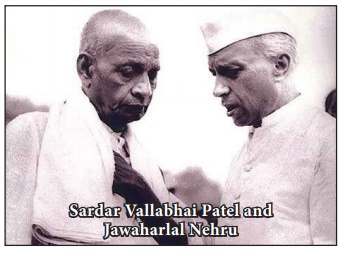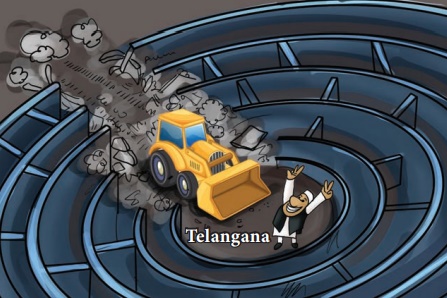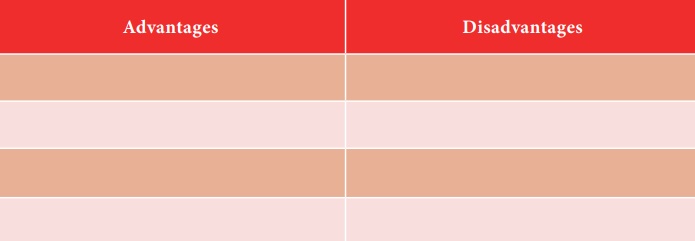Challenges of Nation Building | Political Science - India after Reorganisation | 12th Political Science : Chapter 7 : Challenges of Nation Building
Chapter: 12th Political Science : Chapter 7 : Challenges of Nation Building
India after Reorganisation
India after Reorganisation
After 1947 – Independent India
During the British Colonial period, there were
about 600 administrative units as the Princely States. Depending on the
geographical, cultural, and religious preferences, people were given a choice to
either stay back in the new country India or equally new country Pakistan.
Meanwhile, there were other countries that were formed such as Bhutan. The
current administrative units were formed between 1947 and 1950. Some places
retained their boundaries from British India such as Mysore, Hyderabad, and
Bhopal.
Amidst religious tensions,
post-independence witnessed two nations, India and Pakistan. The independence
of India led to the close of colonial rule and in the reorganisation of States,
which were mostly based on languages, and the rest based on a geographical and
cultural basis. Hence, the new nation of India was restructured and
reorganised, which instituted easier governance and administration. The
reorganisation of the country maintained cultural diversity, linguistic
vibrancy, and glorious heritage. One of the primary concerns for the Indian
government was to instil sentiments of unity and a deep sense of belonging to the
country. During the national movement, Congress did take notice of the impact
vernacular languages had in mobilising powerful participation towards freedom.
Immediately after independence,
the same vigour had to be translated by redrawing the map of India, which was
now destined for self-governance, replacing the colonial mapping, which had
completely negated the local lingual, historical, and cultural dynamics of the
land. The reorganisation of the States and granting self-governance to the
States meant, the central government and the State government had to balance
the powers. However, with the number of agitation that prevailed while
restructuring the States based on language, made it clear, that the Centre was
stronger than the States. Therefore, the process of nation-building was facing
a new ordeal where the country was declared independent, but the States wanted
a similar political consolidation based on ethnicity, geographical borders,
language and more autonomy in local governance. The key leaders who paved the
way for the restructuring include Jawaharlal Nehru and Sardar Vallabhai Patel.
However, the pain of partition and circumstances under which the participation
led to justifiable concerns for the two leaders. They did not want to divide
the country any further because they had a vision a more pluralistic nation, a
unified State than one that should be further divided based on any specific identity
that differentiates people based on religion, language, or ethnicity. Hence,
the apprehension to reorganise the States had its roots from past experiments
and experiences. The former provinces and presidencies served the colonial
administration, now the States had a specific cultural identity, linguistic
individuality, economic viability, geographical placement, political
improvement, and administrative convenience.

Challenges and Negotiations
After the establishment of States, with few more
pending to get independent status as a State, the political and administrative
history of India is placed within the democratic representation of the States,
by legalising their political autonomy constitutionally.
Following the creation of the
States, distribution of resources and right to access to resources became the
next priority. Some States were large, and some were small. Some States,
irrespective of their size, wielded more power than the rest. Therefore, the
Central government had to ensure a balance was maintained between the developed
and the underdeveloped States. This was ensured through assigning impartial
supply of capital, development projects, and labour opportunities. Since the
size of the States differed, smaller States raised concerns that the larger
States would have more control over resources thus, moderating, or even
violating the access of the smaller States to access resources. The result of
such sentiments, will lead to resentment, worsen the economic disparity, and
assert hegemonic usurpation of resources.
Post-independence, the cultural, social, political,
linguistic, and economic restructuring process was implemented for specific
political reasons. Restructuring could not be done with the language being the
only criterion, because it stood in the way of national integration. It gave
certain languages more privilege over the others, which did not go well with
States whose linguistic population was lesser than other dominant languages.
Therefore, structuring of States based on languages sparked a debate between
national identity and linguistic-cultural identity. Some such communities
include Bodos in Assam and the Coorgis in Karnataka. Even if two neighbouring
States, spoke the same language, it still caused unrest concerning the
assertion of national identity owing to caste, ethnic, and religious
differences. Nevertheless, in 1950, 12 languages were recognised but later 22
languages were acknowledged, which shows the growing demand
among linguistic -cultural communities aspiring for political identity.
Borders
Prior to independence, the land
was divided into Provinces, Princely States, and Presidencies. Once States were
declared, the borders had to be negotiated especially between States such as
Karnataka and Maharashtra, Maharashtra and Gujarat, Haryana and Punjab, Odisha
and West Bengal, and between Andhra Pradesh and parts of Madras Presidency.
Apart from the other differences, the dominant
linguistic communities asserted their specific regional and cultural forms of
power and identity. These very specific cultural and linguistic identities
received patronage from the State. Here again, the State had to accommodate the
cultural-linguistic minorities who spoke languages other than the language of
the dominant population.
As expected, the dominant population started to assert
their power over the minorities, by imposing the language of the dominant
linguistic population in administration, education, employment judiciary, and
economy. TO tackle the cultural autonomy, development issues, and regional
inequalities. States had to strategise a standard agenda that ensured overall
development of all linguistic communities. In spite of the efforts by the
government to ensure uniformity, two cultures emerged, the elite and the mass.
Rise of Regional Political Parties
The regional parties across
States started to emerge because of region-based identity movements and loyalty
towards one’s own region. Most of the political parties were capitalised on the
local bases of power. The economic inequality and regional disparities slowed
down the development pace and in some cases stalled progress. When regional
political parties began to emerge, it meant more challenge for the Centre
because the problems at the grassroots were not the same throughout the
country.
Formation of States
The Parliament in recent context
can form a new State by removing a particular locality from any State.
Therefore, a single State has the potential to be multiple States. At the same
time, the Parliament has the power to increase or reduce the land to be
allotted for a particular State. Other powers include changing the boundary and
even the name of the State. However, for all these changes to be implemented, a
bill will be drafted and referred by the President to the legislature of the
State that is in question. The legislature of the State will is granted a
certain period to express their views of the State government and then a
resolution will be presented before the assembly.
If the State Assembly passes the
bill, then the President recommends the introduction of a separate bill in the
Parliament. If the Parliament passes the bill, then the President ratifies it
and a new State comes into existence.
Activity: T-Chart (Graphic Organizer)
T- Charts are a type
of graphic organizer in which a student lists and examines two facets of a
topic, like the ‘pros’ and ‘cons’ associated with it, its advantages and
disadvantages, facts vs. opinions, etc.

Courtesy: The Hindu – 19.2.2014
Topic : Andhra
Pradesh was formally bifurcated by an Act of Parliament on June Telangana
2,2014. The event marked the end of the decades-old movement demandinga
separate state.
Evaluating the pros
and cons of bifurcation of Telangana

Activity: Group Discussion
Topic : After Right to Information and Right to
Education, do you think that the time has
come for a Right to Healthcare legislation given the poor state of public
healthcare infrastructure in our country?
Activity
Setting up a Political Party
Organise groups and
ask them to set up political parties that adhere to the rules of the Indian
Constitution. Explore the procedure from setting up a party, registering it
with the election commission, to contesting in the elections.
Related Topics